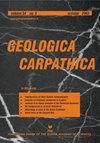爱琴海北部的古近系伸展:土耳其西北部色雷斯盆地早-中始新世的崩积/泥石流沉积
IF 1.5
4区 地球科学
Q4 GEOSCIENCES, MULTIDISCIPLINARY
引用次数: 0
摘要
色雷斯盆地由位于土耳其西北部Strandja高地南部低地的古近系-新近系沉积组成,发育变质岩和变质沉积岩。由塌积扇/碎屑流沉积组成的阿卡兰组是色雷斯盆地北部层序的基底,它被一条被称为“西斯特兰加断裂带”的右侧走滑斜断层所包围。该地层靠近具有释放弯曲的断裂带,具有粗粒、角状、颗粒支撑的特征。细粒的、圆形的和由基质支撑的沉积物发生在远离接触面的地方。在本研究中,阿卡兰组首次被描述为具有较大的底栖有孔虫(LBF):伊波拉-卢tetian的Coskinolina sp,早期卢tetian的Nummulites obesus, Lutetian的Dictyoconus egyptiensis,伊波拉- bartonian的Orbitolites sp,早-中始新世的Miliola sp,早期Lutetian - priabonian的Idalina grelaudae, Ammobaculites agglutinans, Amphimorphina crassa, Dentalina sp., Nodosaria sp., Operculina sp., Lenticulina sp.,始新世的Quinqueloculina属和Amphistegina属。该单元以整合线向上进入中/晚始新世-早渐新世Soğucak组礁灰岩中。有时,石灰岩覆盖在整合面上,这是沉积层序递进的标志。有关西色雷斯盆地的地层、古生物、沉积和构造方面的新发现表明,古近系初期沉积沉积在伊普雷斯—卢特田时期受到强烈的张拉/伸展构造控制。在始新世中晚期Soğucak组海侵沉积时期,右旋滑伸展构造出现活动,盆地随之加深和扩大。本文章由计算机程序翻译,如有差异,请以英文原文为准。
Paleogene extension in the Northern Aegean: Colluvial/debris flow deposits of the Early-Middle Eocene in NW Thrace Basin, Turkey
The Thrace Basin consists of Paleogene–Neogene deposits that lie in the lowland south of the Strandja highlands in NW Turkey, where metagranitic and metasedimentary rocks occur. The Akalan Formation consisting of colluvial fan/debris flow deposits represents the base of the sequence in the northern Thrace basin where it is bounded by a right lateral strike-slip oblique fault called “The Western Strandja Fault Zone”. This formation exhibits a coarse-grained, angular and grain-supported character close to the fault zone which has releasing-bends. Fine-grained, rounded, and matrix-supported sediments occur away from the contact. During this study, the Akalan Formation is described for the first time as having larger benthic foraminifera (LBF) of Coskinolina sp of Ypresian–Lutetian, Nummulites obesus of early Lutetian, Dictyoconus egyptiensis of Lutetian, Orbitolites sp. of Ypresian–Bartonian, Miliola sp of early–middle Eocene, Idalina grelaudae of early Lutetian–Priabonian, Ammobaculites agglutinans, Amphimorphina crassa, Dentalina sp., Nodosaria sp., Operculina sp., Lenticulina sp., Quinqueloculina sp. and Amphistegina sp. of Eocene. This unit passes upward with a conformity into reefal limestones of the middle/late Eocene–early Oligocene Soğucak Formation. At times, the limestone overlies the conformity, there is an indication of a prograding sedimentary sequence. The new stratigraphic, paleontological, sedimentological and structural findings related to the NW Thrace Basin suggest a strong transtensional/extensional tectonic control for the initial Paleogene sedimentary deposition during the Ypresian–Lutetian period as shown by fossil content of the Akalan Formation. Right lateral-slip extensional tectonics appears to have had activity during the middle–late Eocene transgressive deposition of the Soğucak Formation when the basin became deepened and enlarged.
求助全文
通过发布文献求助,成功后即可免费获取论文全文。
去求助
来源期刊

Geologica Carpathica
地学-地球科学综合
CiteScore
2.40
自引率
23.10%
发文量
26
审稿时长
>12 weeks
期刊介绍:
GEOLOGICA CARPATHICA covers a wide spectrum of geological disciplines including geodynamics, tectonics and structural geology, volcanology, stratigraphy, geochronology and isotopic geology, karstology, geochemistry, mineralogy, petrology, lithology and sedimentology, paleogeography, paleoecology, paleobiology and paleontology, paleomagnetism, magnetostratigraphy and other branches of applied geophysics, economic and environmental geology, experimental and theoretical geoscientific studies. Geologica Carpathica , with its 60 year old tradition, presents high-quality research papers devoted to all aspects not only of the Alpine-Carpathian-Balkanian geoscience but also with adjacent regions originated from the Mediterranean Tethys and its continental foreland. Geologica Carpathica is an Official Journal of the Carpathian-Balkan Geological Association.
 求助内容:
求助内容: 应助结果提醒方式:
应助结果提醒方式:


